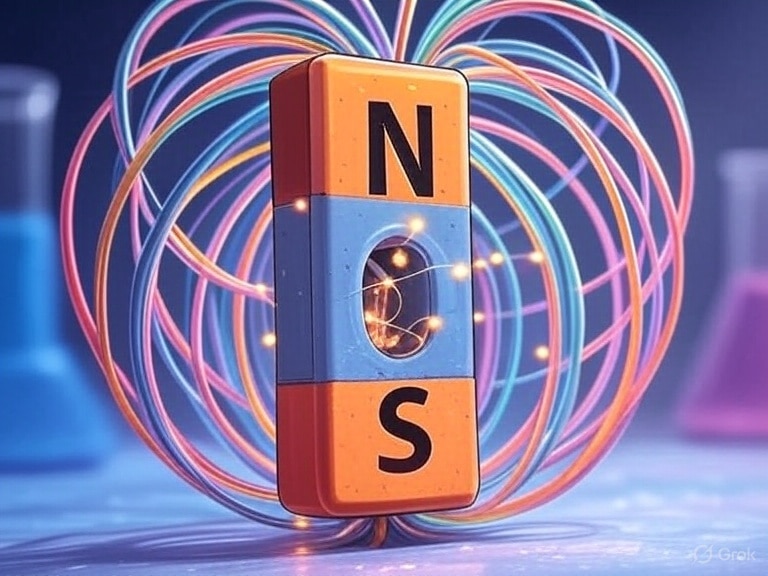The Magic of Magnets
Have you ever played with magnets and noticed how they stick to the fridge, push each other away, or even make your paperclip dance in the air? Magnets seem magical, but scientists have discovered that there is real science behind this mysterious force.
Magnets are everywhere in our world, from refrigerator doors to electric motors, compasses, and even spaceships. Let’s explore the exciting world of magnets and find out how they really work!
What Is a Magnet?
A magnet is an object that can attract certain metals, like iron, nickel, and cobalt. Magnets can also push or pull other magnets, depending on how you arrange them.
- Magnets have two poles: the north pole and the south pole.
- Opposite poles (north and south) attract each other.
- Same poles (north and north or south and south) repel each other.
It’s like an invisible game of push and pull, and it works even if you can’t see it!
How Do Magnets Actually Work?
Magnets work because of something called magnetic fields. You can think of a magnetic field like an invisible force bubble around the magnet.
Inside a magnet:
- Tiny particles called electrons are moving around.
- Electrons have a property called spin, which makes them act like little spinning magnets.
- When many electrons spin in the same direction, their tiny magnetic fields combine, creating a strong magnet.
So, magnets are not magic—they are powered by tiny invisible forces inside atoms!
Types of Magnets
There are three main types of magnets:
- Permanent Magnets
- These magnets always have a magnetic field.
- Examples: fridge magnets, bar magnets, compass needles.
- Temporary Magnets
- These magnets lose their magnetism quickly.
- Examples: paperclips that stick to a strong magnet but stop being magnetic when removed.
- Electromagnets
- These magnets only work when electricity flows.
- Example: cranes that lift cars in junkyards or the magnets in your computer’s speakers.
Electromagnets are especially exciting because you can turn them on and off using electricity!

Fun Experiments With Magnets
Magnets are perfect for experiments, and you can try some at home:
- Floating Paperclip
- Put a magnet under a table.
- Hold a paperclip above it and slowly move it—you’ll feel it being pulled.
- Magnet Push and Pull
- Take two magnets and bring their north poles together—you’ll feel them push away.
- Flip one magnet so north meets south—you’ll feel them snap together!
- Magnetic Sorting
- Gather objects around the house: coins, paperclips, plastic toys.
- Use a magnet to test which items are magnetic.
These experiments help kids see and feel magnetic forces, making science fun and interactive!
Magnets in Everyday Life
Magnets are not just for fun—they are used in many amazing ways:
- Compasses – Magnets point north, helping explorers and sailors find their way.
- Electric Motors – Magnets help turn electricity into movement in toys, fans, and cars.
- Refrigerator Magnets – A fun and practical use to hold notes and drawings.
- MRI Machines – Powerful magnets help doctors see inside our bodies.
So magnets are both playful and powerful!
Magnetic Fields Made Visible
Even though we can’t see magnetic fields with our eyes, we can make them visible:
- Sprinkle iron filings on paper and place a magnet underneath.
- Watch the filings line up along the invisible magnetic field lines.
It’s like a secret pattern drawn by a magical force!
Earth Is a Giant Magnet
Did you know the Earth itself is a huge magnet?
- The Earth has a magnetic north pole and magnetic south pole.
- That’s why compass needles point north—they align with the Earth’s magnetic field.
- The magnetic field also protects us from harmful solar wind—charged particles from the Sun.
Without Earth’s magnetic field, life on our planet would be very different!
Fun Fact Box 🧲
- Magnets were discovered thousands of years ago in a place called Magnesia (in Greece).
- Some animals, like birds and turtles, can sense Earth’s magnetic field to navigate long distances.
- Magnets don’t work on all metals—gold, silver, and aluminum are not attracted to magnets.
Magnets and Science Exploration
Magnets are important for scientists and engineers:
- Space Exploration: Magnets help in satellites, space probes, and experiments on the International Space Station.
- Medical Science: MRI machines use strong magnets to look inside our bodies.
- Technology: Computers, speakers, and phones use tiny magnets to store and read information.
Magnets are everywhere, shaping our world and helping us explore the universe!
Why Magnets Are So Cool
Magnets show us that even though we can’t see everything in science, invisible forces are always working around us. They teach us:
- The world is full of hidden magic waiting to be discovered.
- Small particles like electrons can create big effects.
- Science is both fun and useful in everyday life.
Experiment You Can Try
Here’s one more simple experiment:
Magnetic Maze
- Draw a maze on a piece of paper.
- Put a paperclip on top of the maze.
- Use a magnet underneath to move the paperclip through the maze.
This shows how magnetic forces can move objects without touching them—just like magic!
Conclusion: The Power of Magnets
Magnets are amazing because they combine science, fun, and mystery. They stick, push, pull, float, and guide us in many ways. From tiny fridge magnets to giant electromagnets in machines, magnets show that invisible forces can have real power.
Next time you play with a magnet, remember—you are exploring the same forces that help planes fly, compasses navigate, and even satellites orbit the Earth. Magnets truly are one of nature’s coolest powers!